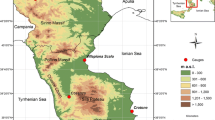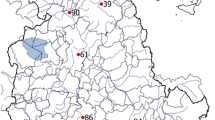Abstract
In this paper, a stochastic model, previously proposed for the maximum daily temperature, has been improved for the combined analysis of mean daily temperature and diurnal temperature range. In particular, the procedure applied to each variable sequentially performs the deseasonalization, by means of truncated Fourier series expansions, and the normalization of the temperature data, with the use of proper transformation functions. Then, a joint stochastic analysis of both the climatic variables has been performed by means of a FARIMA model, taking into account the stochastic dependency between the variables, namely introducing a cross-correlation between the standardized noises. The model has been applied to five daily temperature series of southern Italy. After the application of a Monte Carlo simulation procedure, the return periods of the joint behavior of the mean daily temperature and the diurnal temperature range have been evaluated. Moreover, the annual maxima of the temperature excursions in consecutive days have been analyzed for the synthetic series. The results obtained showed different behaviors probably linked to the distance from the sea and to the latitude of the station.









Similar content being viewed by others
References
Akaike H (1974) Maximum likelihood identification of Gaussian autoregressive moving average models. Biometrika 60:255–265
Anderson TW, Darling DA (1952) Asymptotic theory of certain “goodness-of-fit” criteria based on stochastic processes. Ann Math Stat 23:193–212
Baillie RT, Chung S (2002) Modeling and forecasting from trend stationary long memory models with applications to climatology. Int J Forecasting 18:215–226
Bechini L, Bocchi S, Maggiore T, Confalonieri R (2006) Parameterization of a crop growth and development simulation model at sub-model components level. An example for winter wheat (Triticum aestivum L.) Environ Model Softw 21:1042–1054
Box GEP, Jenkins GM (1976) Time series analysis: forecasting and control. Holden-Day, SanFrancisco
Burnham KP, Anderson DR (2002) Model selection and multimodel inference: a practical information-theoretic approach. Springer, New York
Buttafuoco G, Caloiero T, Coscarelli R (2015) Analyses of drought events in Calabria (southern Italy) using standardized precipitation index. Water Resour Manag 29:557–573
Caballero R, Jewson S, Brix A (2002) Long memory in surface air temperature: detection, modeling, and application to weather derivative valuation. Clim Res 21:127–140
Caldiz DO, Gaspari FJ, Haverkort AJ, Struik PC (2001) Agro-ecological zoning and potential yield of single or double cropping of potato in Argentina. Agric For Meteorol 109:311–320
Caloiero T, Coscarelli R, Ferrari E, Sirangelo B (2015) Analysis of dry spells in southern Italy (Calabria). Water 7:3009–3023
Cardon AH, Fukuda H, Reifsnider KL, Verchery G (eds) (2000) Recent development in durability analysis of composite systems. A.A. Balkeema, Rotterdam, Brookfield ISBN 90 5809 103 1
Coscarelli R, Caloiero T (2012) Analysis of daily and monthly rainfall concentration in southern Italy (Calabria region). J Hydrol 416–417:145–156
Curriero FC, Heiner KS, Samet JM, Zeger SL, Strug L, Patz JA (2002) Temperature and mortality in 11 cities of the eastern United States. Am J Epidemiol 155:80–87
Ehsanzadeh E, Adamowski K (2010) Trends in timing of low stream flows in Canada: impact of autocorrelation and long-term persistence. Hydrol Process 24:970–980
Ferrari E, Caloiero T, Coscarelli R (2013) Influence of the North Atlantic oscillation on winter rainfall in Calabria (southern Italy). Theor Appl Climatol 114:479–494
Franco T (1991) Effects of stressful and unstressful low temperature on vegetable crops: morphological and physiological aspects. Acta Hortic 287:67–76. https://doi.org/10.17660/ActaHortic.1991.287.6
Granger CWJ, Joyeux R (1980) An introduction to long-range time series models and fractional differencing. J Time Ser Anal 1:15–30
Grimaldi S (2004) Linear parametric models applied on daily hydrological series. J Hydrol Eng 9:383–391
Grimaldi S, Serinaldi F, Tallerini C (2005) Multivariate linear parametric models applied to daily rainfall time series. Adv Geosci 2:87–92
Hajat S, Kovats RS, Atkinson RW, Haines A (2002) Impact of hot temperatures on death in London: a time series approach. J Epidemiol Community Health 56:367–372
Hosking JRM (1981) Fractional differencing. Biometrika 68:165–176
Hosking JRM (1984) Modeling persistence in hydrological time series using fractional differencing. Water Resour Res 20:1898–1908
Hurst HE (1951) Long-term storage capacity of reservoirs. Trans Am Soc Civil Eng 116:770–799
Johnson NL (1949) Systems of frequency curves generated by methods of translation. Biometrika 36:149–176
Keellings D, Waylen P (2012) The stochastic properties of high daily maximum temperatures applying crossing theory to modeling high temperature event variables. Theor Appl Climatol 108:579–590
Koscielny-Bunde E, Kantelhardt JW, Braun P, Bunde A, Havlin S (2006) Long-term persistence and multifractality of river runoff records: detrended fluctuation studies. J Hydrol 322:120–137
Koutsoyiannis D (2002) The Hurst phenomenon and fractional Gaussian noise made easy. Hydrolog Sci J 47:573–595
Kunst AE, Looman CWN, Mackenbach JP (1993) Outdoor air temperature and mortality in the Netherlands: a time-series analysis. Am J Epidemiol 137:331–341
Lohre M, Sibbertsen P, Könning T (2003) Modeling water flow of the Rhine River using seasonal long memory. Water Resour Res 39:1132
Lye LM, Lin Y (1994) Long-term dependence in annual peak flows of Canadian rivers. J Hydrol 160:89–103
Montanari A, Rosso R, Taqqu MS (1997) Fractionally differenced ARIMA models applied to hydrologic time series: identification, estimation, and simulation. Water Resour Res 33:1035–1044
Montanari A, Rosso R, Taqqu MS (2000) A seasonal fractional ARIMA model applied to the Nile River monthly flows at Aswan. Water Resour Res 36:1249–1259
Pelletier JD, Turcotte DL (1997) Long-range persistence in climatological and hydrological time series: analysis, modeling and application to drought hazard assessment. J Hydrol 203:198–208
Prass TS, Bravo JM, Clarke RT, Collischonn W, Lopes SRC (2012) Comparison of forecasts of mean monthly water level in the Paraguay River, Brazil, from two fractionally differenced models. Water Resour Res 48:W05502
Sirangelo B, Caloiero T, Coscarelli R, Ferrari E (2017) A stochastic model for the analysis of maximum daily temperature. Theor Appl Climatol 130:275–289
Smith RL (1993) Long-range dependence and global warming. In: Barnett V, Turkerman KF (eds) Statistics for the environment. Wiley, New York, pp 141–146
Sugiura N (1978) Further analysis of the data by Akaike’s information criterion and the finite corrections. Commun Stat A-Theor 7:13–26
Verdoodt A, Van Ranst E, Ye L (2004) Daily simulation of potential dry matter production of annual field crops in tropical environments. Agron J 96:1739–1753
Ye L, Tang H, Zhu J, Verdoodt A, Van Ranst E (2008) Spatial patterns and effects of soil organic carbon on grain productivity assessment in China. Soil Use Manag 24:80–91
Ye L, Van Ranst E (2002) Population carrying capacity and sustainable agricultural use of land resources in Caoxian County (North China). J Sustain Agr 19:75–94
Ye L, Van Ranst E (2009) Production scenarios and the effect of soil degradation on long-term food security in China. Global Environ Chang 19:464–481
Ye L, Xiong W, Li Z, Yang P, Wu W, Yang G, Fu Y, Zou J, Chen Z, Van Ranst E, Tang H (2013) Climate change impact on China food security in 2050. Agron Sustain Dev 33:363–374
Author information
Authors and Affiliations
Corresponding author
Rights and permissions
About this article
Cite this article
Sirangelo, B., Caloiero, T., Coscarelli, R. et al. A combined stochastic analysis of mean daily temperature and diurnal temperature range. Theor Appl Climatol 135, 1349–1359 (2019). https://doi.org/10.1007/s00704-018-2441-5
Received:
Accepted:
Published:
Issue Date:
DOI: https://doi.org/10.1007/s00704-018-2441-5




